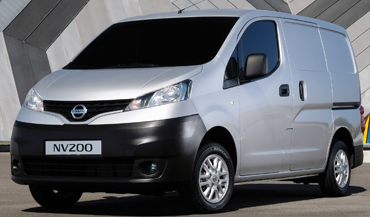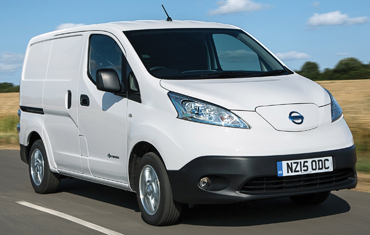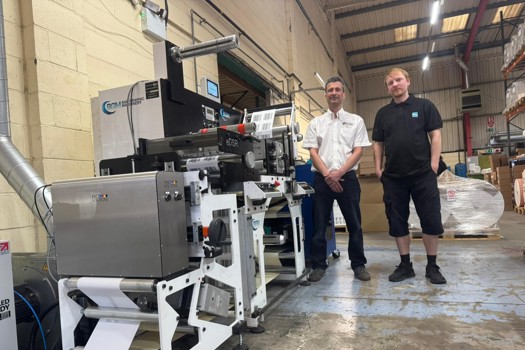Electric vans have got some way to go in order to get to this level of sophistication, but some huge leaps have been made. Last year, Nissan released the acclaimed electric van the E-NV200, while the Japanese firm’s French cousin Renault offers the similarly priced and specced Kangoo ZE. Expectations were that Nissan would price the E-NV200 at around £30,000 on-the-road, but the Japanese manufacturer pulled a surprise when it revealed that it would be priced similarly to its diesel-powered equivalent, the NV-200. Since January 2013, Mercedes-Benz has also offered its popular Vito van as an electric variant while the Renault Twizy Cargo could be an eye-catching, leftfield option for eccentrically minded printers who only need to lug tiny volumes around urban centres.
According to the Society of Motor Manufacturers and Traders (SMMT), the electric and hybrid van market grew by 60% last year. It’s still a relative drop in the ocean compared to the total volume of vehicles sold in the UK, but it shows that demand for eco vehicles is growing.
Cost savings
According to the Low Carbon Vehicle Partnership, opting for a low-carbon vehicle instead of a conventional one could save firms a whopping £18,000 in running costs over the vehicle’s lifetime. Nevertheless, the total number of electric or hybrid vans on the road is still relatively tiny.
Electric vans seemingly make many compelling financial cases. They’re exempt of the London Congestion Charge, you don’t need to tax them and a government grant will pay for 20% of the price of an electric van, up to £8,000. The dealership will even do the paperwork for you. For an industry that is constantly looking for new ways to be more environmentally friendly, they offer a very public way for companies to shout about green credentials. But the thorny issue of range, not to mention practicality, means that the print trade has largely been unconvinced thus far.
CFH Docmail is one of the few printers that uses electric vehicles, but has opted for a line-up of stripped-out Nissan Leafs (which shares its underpinnings with the E-NV200) to carry its wares instead of vans. “The E-NV200 looks tempting, but for our current volumes the Leaf is more than sufficient,” says Broadway. “But we’re keeping an eye out for a new electric van. It’s a case of ‘wait and see’.”
Nigel Pealing of Gloucester-based printer Severnside isn’t convinced that the electric van is for them yet, either. “It’s something we’ve looked into. We actually tried one, but the range and payload limitations are an issue,” he says. “If you have a tonne of print in the back and have to go up a few hills, it really does drain the battery quickly.”
The prospect of a hybrid van, which has both a traditional diesel engine, aligned with an electric motor for low speeds, would probably be the best compromise. However, there are quite simply none available in the UK yet – a rather mystifying state of affairs considering the runaway success of cars like the Toyota Prius.
“This is perhaps in part because the leader in hybrids, Toyota, is not a significant player in the European van market. Honda is not either. Other manufactures have been slower to catch up, with hybrid technologies appearing, predictably, on the heavier 4x4s and sports cars with the main aim of enhancing acceleration rather than making a dubious contribution to fuel economy and CO2 emissions. But I suspect there will be some hybrid vans in the pipeline,” says Peter Wells, professor of business and sustainability at Cardiff University.
With a 96% market share, it doesn’t look like diesel vans are going to disappear in a hurry. They’ve managed to weather the challenge of a number of pretenders to the throne – not least from vans converted to run on liquefied petroleum gas (LPG). These still have a niche following, even if they have seriously waned in popularity in recent years. “There is currently little demand from UK motorists for LPG vehicles,” says Ben Foulds, spokesman for the SMMT. “The infrastructure for plug-in vehicles in the UK is currently benefiting from significant investment and developing rapidly, which is not the case for LPG.”
Besides, diesel engines are getting much cleaner and economical thanks to developments in engine technology and aerodynamics. Small vans like the Peugeot Bipper and Fiat Fiorino are capable of in excess of 60 miles per gallon if driven conservatively, and it isn’t unusual for large vans to be able to squeeze out 40 miles per gallon and upwards.
Perhaps one of the quickest and easiest ways for printers to reduce the running costs of their vans is by simply driving their vans more effectively, and maintaining them so they’re as efficient as possible. The Energy Saving Trust claims that drivers could improve their van’s efficiency by about 15% by just making some behavioural changes, like shifting up gear at 2,000rpm, relying on windows to keep cool under 60mph then switching to air conditioning at faster speeds to stay aerodynamic. It also advises a more ‘smooth’ approach to driving, avoiding sharp and sudden bouts of acceleration.
Driver monitoring
Of course, it’s one thing making sure that your drivers are educated in the ways of driving economically – it’s another thing actually getting them to do it day-in, day-out. Fortunately, there’s a technological answer to this conundrum. Enter, Lightfoot, a rather clever driver monitoring system made by Devon company Ashwood Automotive. It’s already helping many fleet managers cut their running costs.
The company’s fuel calculator suggests that a business running three vans, each doing around 50,000 miles a year could be in line to save £3,325 in fuel and make a CO2 saving of around 3.64 tonnes every year. The system keeps an eye on a driver’s behaviour, offering guidance as to how to drive more economically – and safely – in real time, and sends a weekly or monthly email report to the fleet manager to check on how they’re driving.
So, at the moment, diesel looks like it will continue to provide the most versatile, varied and practical option for printers who need to move their goods around. If investing in a plug-in van is something that you are set on exploring, however, it’s probably worth waiting to see how the market develops.
If the electric car market is anything to go by, we may well soon be inundated with cheap, ‘previously loved’ electric vans. Depreciation on electric cars is – no pun intended – truly shocking, with year-old examples of cars like the Nissan Leaf and Renault Zoe going for thousands less than their showroom price. (Automotive trade intelligence company CAP Consulting has argued in a recent report that this staggering plummet in value is actually because of those aforementioned subsidies distorting the vehicles’ actual values.) Bargain-basement used prices, aligned with low running costs, could mean that the electric van represents a much less risky proposition for printers to take sooner than you might think.
Crunching the numbers - how do electric and diesel counterparts stack up?
Nissan NV-200 Acenta
 List price £14,525
List price £14,525
Engine 1.5 litre diesel
Power 66kW at 4,000rpm
Top speed 105mph
Acceleration 0-62mph in 13.6 seconds
Maximum payload 621-635kg
Consumption (claimed) 56.5mpg combined
CO2 emissions 130g/km
Anything else? You’ll have the benefit of topping the diesel NV-200 Acenta up at any garage forecourt that takes your fancy, and it’ll only take a matter of minutes to get a full tank. It’s a mega-seller, so there are a lot of used examples on the market, and parts and spares are in abundance. If it goes wrong, your local mechanic won’t need to have had a stint at NASA to fix it.
Nissan E-NV200 Acenta
 List price £13,568 with £61 per month battery rental, £16,737 with ownership of battery
List price £13,568 with £61 per month battery rental, £16,737 with ownership of battery
Engine 80kW electric
Top speed 75mph
Acceleration 0-62mph in 14 seconds
Maximum payload 708 kg
Consumption (claimed) 165Wh/km
CO2 emissions 0kg/km
Anything else? The E-NV200 is quiet, clean and free of all manner of sundry legislative charges. However, it has a relatively paltry range of 106 miles on a full charge, and when you do need to juice-up, it could take around eight hours. (You’ll also need to shell out £350 for an at-home charging kit – it’s not as easy as just putting a three-pin plug in, unfortunately). There are charging stations around the country for you to use when out and about – including time-saving rapid ones which drastically slash the time to fuel up – but they are relatively rare and concentrated in the south east of England and urban areas.










